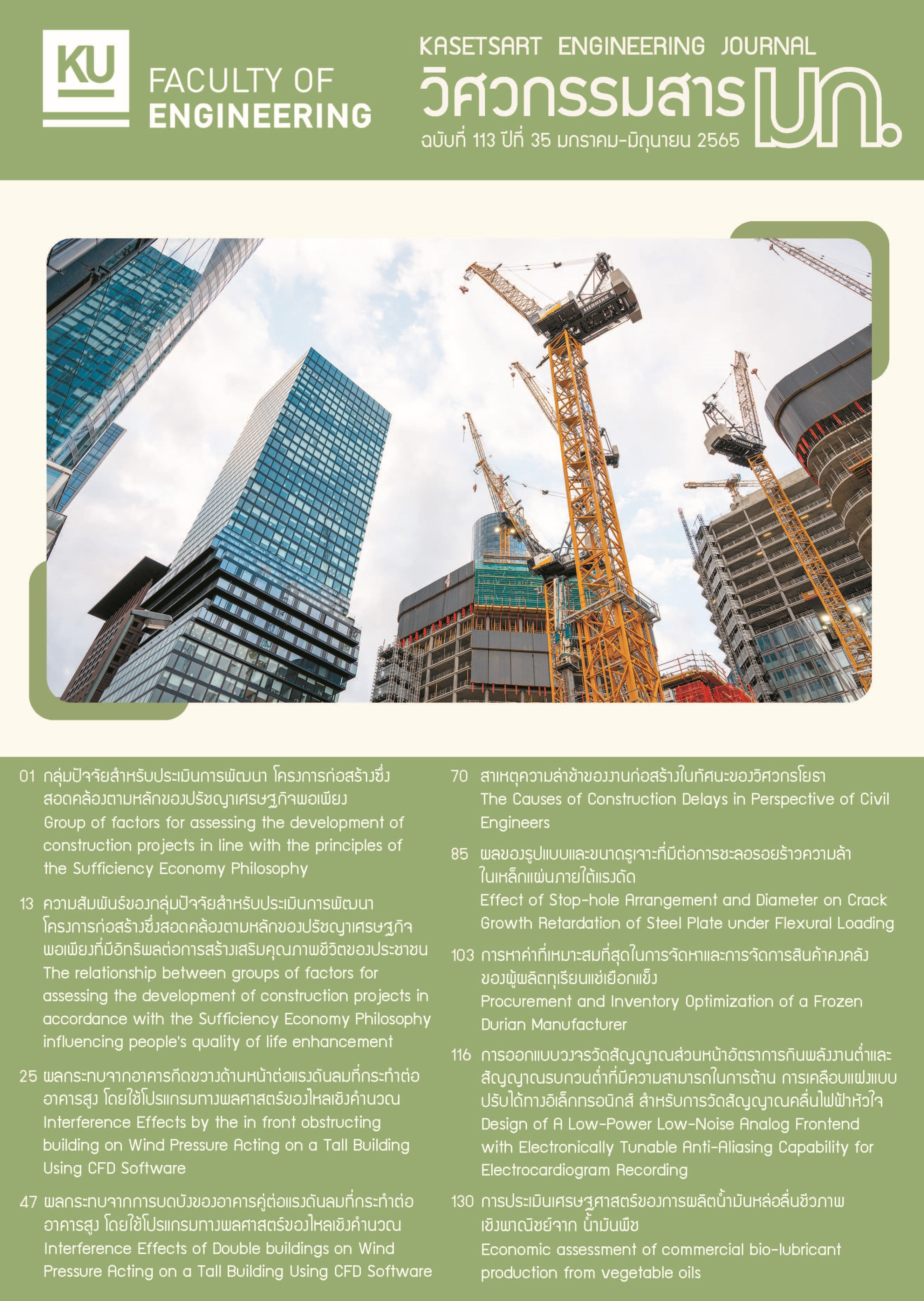Effect of Stop-hole Arrangement and Diameter on Crack Growth Retardation of Steel Plate under Flexural Loading
Keywords:
crack growth retardation, fatigue crack, finite element, stop-drill hole, stop-hole locationAbstract
This paper presents the effects of stop-hole arrangement and diameter (D) of a single stop-drill hole (SDH), double SDH, and crack flank holes (CFH) on the fatigue life extension of steel plate under out-of-plane flexural loading. The effect of stop-hole configurations on fatigue crack retardation was experimentally investigated on six steel plate specimens with a central through-thickness crack and a stress ratio (R) of -1. Finite element models were developed to evaluate the stress intensity factor at crack tips and the stress concentration around SDH. The experimental and analytical results showed that SDH effectively retarded the propagation of fatigue cracks under flexural loading. The finite element models considering crack surface interference provided a reasonable estimate of the stress intensity factor at crack tips and a prediction of the crack growth direction. The stress concentration around stop holes decreased with an increase in D. For the same D, CFH gave the lowest stop-hole stress concentration, which provided the longest fatigue life initiation from the drilled hole, followed by double SDH and single SDH, respectively. The CFH with a distance between the crack tip and center of the drilled holes of -0.25D provided the most significant fatigue crack retardation.
References
R J Dexter and J M Ocel (2013). Manual for repair and retrofit of fatigue cracks in steel bridges. Federal Highway Administration, FHWA-IF-13-020.
L Fang, Z Fu, B Ji, and Q Wang (2023). Interference of cracking and drilling on opposite side of steel deck components. Journal of Constructional Steel Research, 208: 107996.
FHWA (2013). Manual for Repair and Retrofit of Fatigue Cracks in Steel Bridges.
FHWA (2012). Manual for Design, Construction and Maintenance of orthotropic steel deck bridges.
H Wu, A Imad, N Benseddiq, J T P D Castro, and M A Meggiolaro (2010). On the prediction of the residual fatigue life of cracked structures repaired by the stop-hole method. International Journal of Fatigue, 32: 670-677.
C S Shin, C M Wang, and P S Song (1996). Fatigue damage repair: a comparison of some possible methods. International Journal of Fatigue, 18: 535-546.
M S Ferdous, C Makabe, M S Rana, and T Miyazaki (2011). Improving the fatigue strength of a multiple hole specimen by applying additional holes or notches, Engineering Failure Analysis, 18: 75-87.
S M J Razavi, M R Ayatollahi, and F Berto (2018). Assessment of fatigue crack growth behavior of cracked specimens repaired by indentation. Procedia Structural Integrity, 13: 69-73.
Y Hu, M Song, J Liu, and M Lei (2020). Effects of stop hole on crack turning, residual fatigue life and crack tip stress field. Journal of the Brazilian Society of Mechanical Sciences and Engineering, 42: 216.
P S Song, Y L Shieh (2004). Stop drilling procedure for fatigue life improvement. International Journal of Fatigue, 26: 1333-1339.
M R Ayatollahi, S M J Razavi, and M Y Yahya (2015). Mixed mode fatigue crack initiation and growth in a CT specimen repaired by stop hole technique. Engineering Fracture Mechanics, 145: 115-127.
S M J Razavi, M R Ayatollahi, C Sommitsch, and C Moser (2017). Retardation of fatigue crack growth in high strength steel S690 using modified stop-hole technique, Engineering Fracture Mechanics, 169: 226-237.
M R Ayatollahi, S M J Razavi, and H R Chamani (2014). A numerical study on the effect of symmetric crack flank holes on fatigue life extension of a SENT specimen. Fatigue and Fracture of Engineering Materials and Structures, 37: 1153-1164.
M Li, Y Suzuki, K Hashimoto, K Sugiura (2018). Experimental study on fatigue resistance of rib-to-deck joint in orthotropic steel bridge deck. Journal of Bridge Engineering, 23(2): 04017128.
มาตรฐานผลิตภัณฑ์อุตสาหกรรม (มอก. 1479-2558) (2558).เหล็กกล้าทรงแบนรีดร้อนสำหรับงานโครงสร้างทั่วไป, สำนักงานมาตรฐานผลิตภัณฑ์อุตสาหกรรม, กระทรวงอุตสาหกรรม.
IIW (2012). Recommendations for fatigue design of welded joints and components.
M Li, K Hashimoto, and K Sugiura (2014). Influence of Asphalt Surfacing on Fatigue Evaluation of Rib-to-Deck Joints in Orthotropic Steel Bridge Decks. Journal of Bridge Engineering, 04014038.
G M Sayeed Ahmed, A Algahtani, E R I Mahmoud, and I A Badruddin (2018). Experimental evaluation of interfacial surface cracks in friction welded dissimilar metals through image segmentation technique (IST). International Journal of Materials, 11: 2460.
P Albrecht, and A Lenwari (2006). Stress intensity factor for center-cracked plate with crack surface interference. Engineering Fracture Mechanics, 73: 1035-1045.
Y Lei (2008). Finite element crack closure analysis of a compact tension specimen. International Journal of Fatigue, 30: 21–31.
NASGRO (2010). Fracture mechanics and fatigue crack growth analysis software (version 6.0), reference manual, NASA Johnson Space Center and Southwest Research Institute.
H A Richard, B Schramm, and N H Schirmeisen (2014). Cracks on Mixed Mode loading-Theories, experiments, simulations. International Journal of Fatigue, 62: 93-103.
Downloads
Published
Issue
Section
License

This work is licensed under a Creative Commons Attribution-NonCommercial-NoDerivatives 4.0 International License.


